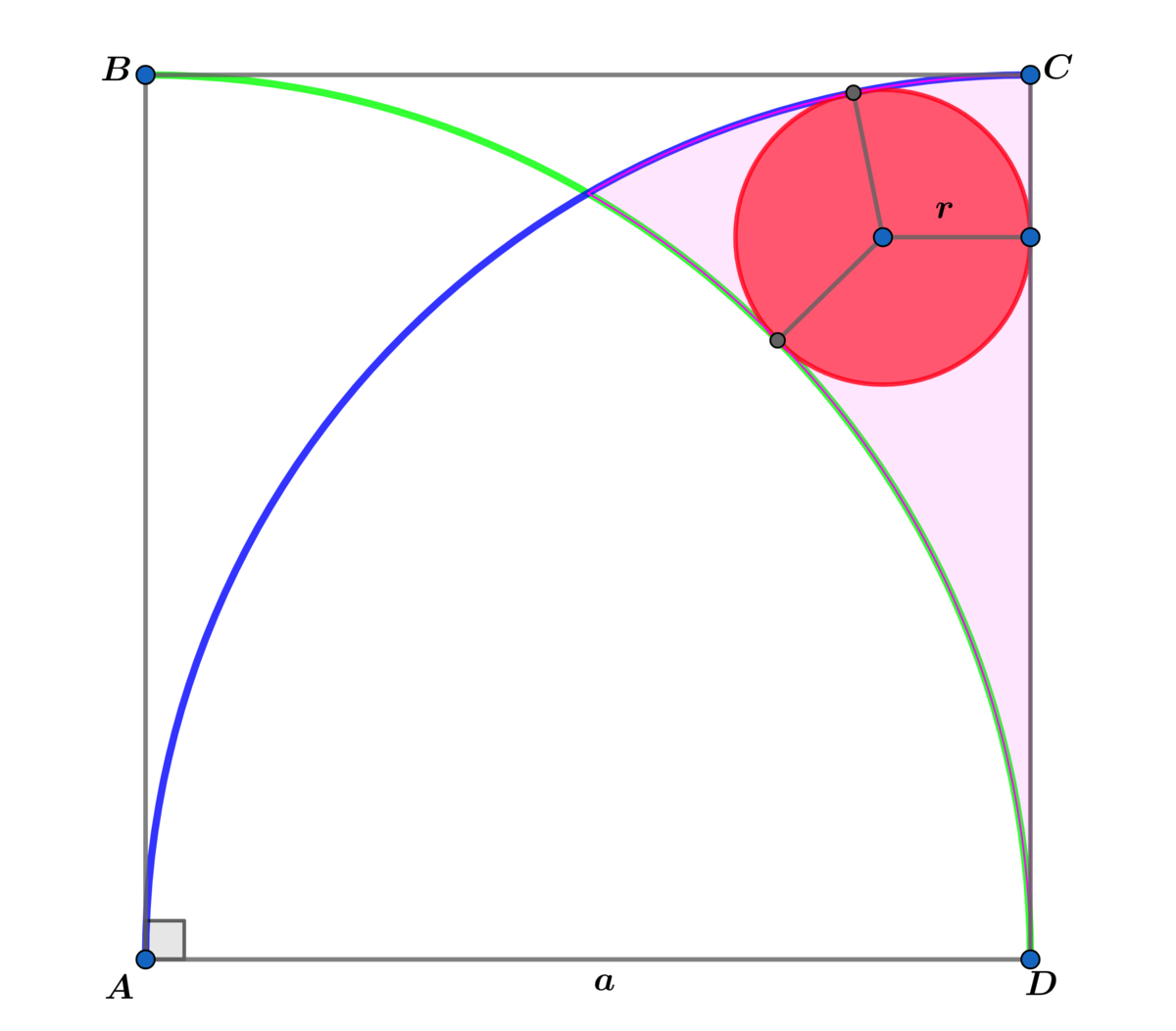What's the Pink Area?

In square A B C D with side length a , we have two inscribed quarter circles and a red circle with radius r which is tangent to both quarter circles and tangent to C D as shown above.
Let A p be the area of the pink region.
If a 2 A p = β α − λ π , where α , β and λ are coprime positive integers, find α + β + λ .
The answer is 16.
This section requires Javascript.
You are seeing this because something didn't load right. We suggest you, (a) try
refreshing the page, (b) enabling javascript if it is disabled on your browser and,
finally, (c)
loading the
non-javascript version of this page
. We're sorry about the hassle.
2 solutions

Using the above diagram h 2 = ( a + r ) 2 − ( a − r ) 2 = ( a − r ) 2 − r 2 ⟹
4 a r = a 2 − 2 a r ⟹ 6 a r = a 2 ⟹ r = 6 a ⟹ the area of the red circle is A c = 3 6 a 2 π
The equations of the blue and green quarter circles are:
x 2 + y 2 = a 2
( x − a ) 2 + y 2 = a 2
Solving the two equations above we obtain x = 2 a ⟹
I = ∫ 2 a a a 2 − ( x − a ) 2 − a 2 − x 2 d x
For I 1 = ∫ 2 a a a 2 − ( x − a ) 2 d x
Let x − a = a sin ( θ ) ⟹ d x = a cos ( θ ) d θ ⟹
I 1 = 2 a 2 ( θ + 2 1 sin ( 2 θ ) ) ∣ − 6 π 0 = 2 a 2 ( 6 π + 4 3 )
For I 2 = ∫ 2 a a a 2 − x 2 d x
Let x = a sin ( θ ) ⟹ d x = a cos ( θ ) d θ ⟹
I 2 = 2 a 2 ( θ + 2 1 sin ( 2 θ ) ) ∣ − 6 π 2 π = 2 a 2 ( 3 π − 4 3 )
⟹ I = 2 a 2 ( 2 3 − 6 π ) ⟹ A p = I − A c = ( 4 3 − 9 π ) a 2 ⟹
a 2 A p = 4 3 − 9 π = β α − λ π ⟹ α + β + λ = 1 6 .
A G 2 = D A 2 + D G 2 − 2 D A ⋅ D G ⋅ cos ( ∠ A D G ) ⇒ ( a + r ) 2 = a 2 + ( a − r ) 2 − 2 a ( a − r ) cos ( 9 0 ∘ − θ ) ⇒ a 2 + 2 a r + r 2 = a 2 + a 2 − 2 a r + r 2 − 2 a ( a − r ) sin ( θ ) ⇒ 4 a r = a 2 − 2 a ( a − r ) a − r r ⇒ 6 a r = a 2 ⇒ r = 6 a Now, for the area A p of the pink region,
A p i n k = A ( D , EC ⌢ ) − ⎝ ⎛ A ( A , E D ⌢ ) − [ A E D ] ⎠ ⎞ − A r e d c i r c l e = 2 1 ⋅ 6 π ⋅ a 2 − ( 2 1 ⋅ 3 π ⋅ a 2 − 4 a 2 3 ) − π ( 6 a ) 2 = … = ( 4 3 − 9 π ) a 2
Hence, a 2 A p = 4 3 − 9 π For the answer, α = 3 , β = 4 , λ = 9 , thus, α + β + λ = 1 6 .